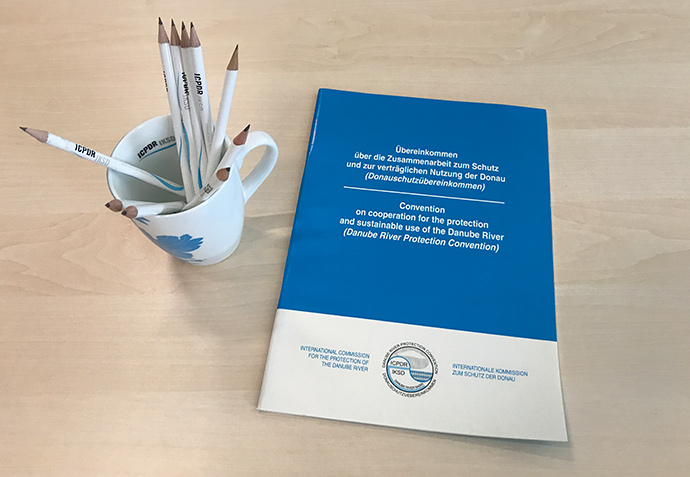Danube Watch 2/2019 - From Convention to Action
From Convention to Action

Joachim Bendow, first Executive Secretary of the ICPDR and Ursula Schmedtje, first Technical Expert for River Basin Management at the ICPDR Secretariat (right).
T he ICPDR celebrates its 25th year of existence this year, with its foundation and work directly tied to the Danube River Protection Convention of 1994. The efforts and steps required to accomplish the signing of the convention and to then begin action based on this founding document were tremendous and deserve to be highlighted.
In 1985, Danube countries had agreed in the ‘Bucharest Declaration on Water Management of the Danube River’ to coordinate water management activities. The goals were ambitious but the political and economic situation in the region at the time hindered effective implementation.
Not long after massive regional political changes affected Central and Eastern Europe (CEE), the idea of creating a ‘Danube River Protection Convention (DRPC)’ was supported by Danube countries at the first UNECE ‘Environment for Europe’ conference held at the Dobris Castle in the Czech Republic in June 1991.

The foundational text at the core of the ICPDR's raison d'être, the Danube River Protection Convention, continues to lay the groundwork for multilateral cooperation between all Danubian states necessary for the preservation of the river and its tributaries
Building on this momentum, 24 countries, Global Environment Facility (GEF)/United Nations Development Programme (UNDP), the European Commission and NGOs met in Sofia, Bulgaria in September 1991 to plan the next steps. The result was the birth of the jointly agreed upon ‘Environmental Programme for the Danube River Basin (EPDRB)’, a framework initiative for regional cooperation in water management that would initiate priority studies and actions supporting the establishment of the DRPC.
The EPDRB was managed and mainly funded by the EU Phare Multi-Country Programme for Environment and UNDP, which planned to draw funds from the emerging Global Environmental Facility (GEF) to implement EPDRB activities. The EPDRB was extremely important in that it was the first regional programme ever to be approved by both organisations.
The need for a DRPC was further driven by Danube countries becoming Parties to the new UNECE Convention on the Protection of Transboundary Rivers and Lakes signed in Helsinki in March 1992. It obliged Parties to prevent transboundary impacts on watercourses and encouraged them to cooperate through river basin management agreements. In effect, the ‘Helsinki Convention’ would become the basis for the DRPC.
On the 29th of June 1994 in Sofia, Bulgaria, 11 Danube countries (Austria, Bulgaria, Croatia, the Czech Republic, Germany Hungary, Moldova Romania, Slovakia, Slovenia and Ukraine) and the European Commission (EC) signed the Danube River Protection Convention (DRPC).
It has become the overall legal framework for protecting and sustainably using water and other shared ecological resources. The main objective of the Danube River Protection Convention is to ensure that surface waters and groundwater within the Danube River Basin are managed and used sustainably and equitably. This involves:
- the conservation, improvement and rational use of surface waters and groundwater.
- preventive measures to control hazards originating from accidents involving floods, ice or hazardous substances.
- measures to reduce the pollution loads entering the Black Sea from sources in the Danube River Basin.
The signatories to the DRPC have agreed to co-operate on fundamental water management issues by taking "all appropriate legal, administrative and technical measures to at least maintain and where possible improve the current water quality and environmental conditions of the Danube river and of the waters in its catchment area, and to prevent and reduce as far as possible adverse impacts and changes occurring or likely to be caused".
The DRPC came into force on the 22nd of October 1998. Days later, the International Commission for the Protection of the Danube River (ICPDR) and its Permanent Secretariat were established. Between 1998 and 2000, the ICPDR, mainly through its Expert Groups, cooperated with the GEF/UNDP and the EC in implementing the 'Environmental Programme for the Danube River Basin' (EPDRB).
In 2000, the EPDRB officially ended. This proved to be a major milestone whereby the lead in managing the Danube Basin shifted from donors to the ICPDR and the Danube countries themselves, with continued and targeted GEF/UNDP support.

Done at Sofia, this 29th day of June 1994. Convention on Cooperation for the Protection and Sustainable use of the Danube River (Danube River Protection Convention)
Also in 2000, the ICPDR Heads of National Delegations agreed that the implementation of the EU's Water Framework Directive (WFD) should become the highest priority for the ICPDR for the coming years. Ministers from all of the Danube countries gave their full commitment to back the decision, including members of the EU, prospective members and non-members. They further pledged to develop a single, Basin-wide Danube River Basin Management Plan (DRBMP) and nominated the ICPDR as its coordinating body. The decision made sense given that both the WFD and ICPDR were based on using integrated river basin management (IRBM).
In 2000, the EU adopted the Water Framework Directive (WFD), which acts as an effective tool for water management and is one of the strongest pieces of water protection legislation in the world. ICPDR Heads of Country Delegates decided that the implementation of the WFD should be of the highest priority and all Danube countries agreed, both EU member states and potential member states. Since then, the ICPDR has worked to strengthen the capacity of Danube countries to meet the EU's accession requirements. This leads to a positive outcome for all sides as political and economic incentives for environmental compliance resulting from the EU accession process promote the speedier implementation of the Danube River Protection Convention's objectives.
The five-year Danube Regional Project (DRP) was launched in 2001 and constituted the last phase of GEF/UNDP long-term support for IRBM in the Danube Basin. Its main goal was to strengthen the capacity of the ICPDR and Danube countries to cooperate in fulfilling their commitments to implement the Danube Convention, to reduce nutrient pollution entering the Black Sea and to the WFD. It built on the GEF Transboundary Diagnostic Analysis to help develop the 2004 Danube River Basin Analysis and eventually the Danube River Basin Management Plan. The DRP and significant involvement of the GEF/UNDP in the Danube Basin then ended in 2007.
The first Joint Danube Survey was conducted in 2001 with the goal of providing comparable and reliable information on the water quality of the entire course of the Danube River. The survey (and its subsequent iterations) help Danube governments implement the Danube River Protection Convention as well as the EU Water Framework Directive. The data collected, cooperation fostered and awareness raised by these surveys has proven to be incredibly valuable for the work of the ICPDR and the achievement of the Convention's vision.
With this key groundwork in place, ICPDR and its partners have been able to make great strides in securing the future of the Danube River, its tributaries and the 80 million people who depend on the Danube's waters. The future growth of cooperation and action stems from the work leading to the Danube River Protection Convention and the subsequent path toward action that took place over its first decade of existence. The DRPC truly shows what can be accomplished with clarity of vision and dedication to action.







